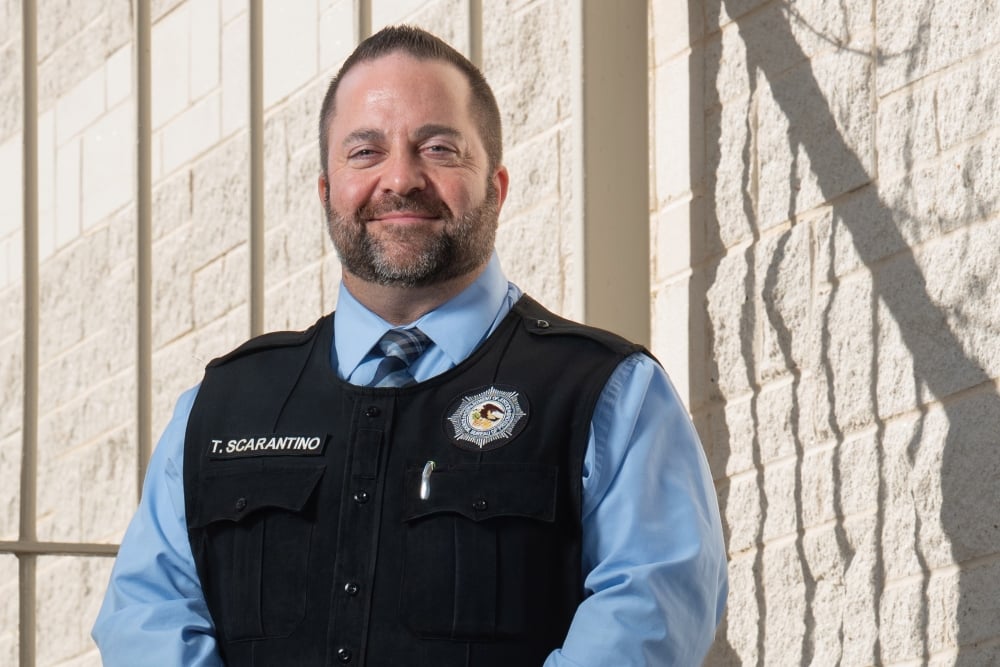“This is not Club Fed,” asserted Thomas “Tommy” Scarantino, the complex warden at the Federal Correctional Complex in Butner, North Carolina. “And it’s not ‘Orange Is the New Black,’” asserted another prison staff member in the warden’s office during our interview.
With high-profile inmates including Bernie Madoff, Ted Kaczynski (the Unabomber), singer R. Kelly, members of Congress, spies, “Tiger King” Joe Exotic and organized crime kingpins came the assumption of easy time. The notion of Club Feds with golf courses, tennis courts and private chefs came about in 2004 when Martha Stewart was incarcerated at the Minimum-Security Federal Prison Camp in Alderson, West Virginia. Stewart said her time in prison was “horrifying.”
“Anybody that indicates FCC Butner is a Club Fed or any other BOP [Bureau of Prisons] facility has never been in one,” said Scarantino. “Everybody is treated the same. We balance security with rehabilitation and programming. I’ve never seen a golf course at any federal prison.”
Cancer Treatment Center
Butner is a men’s only federal prison complex in Granville County, North Carolina, 25 miles from Raleigh, with approximately 4,200 minimum, low, medium, and high-security inmates. BOP has approximately 158,000 inmates in 122 federal prisons nationwide.
Most high-profile inmates, like many of the other 4,200 inmates, are at Butner for medical and/or psychological treatment at the Federal Medical Center (FMC). Butner is one of the two largest federal correctional complexes in the BOP, and the only medical complex in the BOP.
Butner is unique as the only FMC prison that provides radiation and chemotherapy to treat cancer. A new $13.3 million linear accelerator facility will open on-site in 2024 to replace an aging unit. A linear accelerator is a machine used for cancer radiation treatment. The specialized chemotherapy, radiation therapy, and the host of other medical treatments offered to the inmates at Butner saves over $300 million annually by sending sick inmates to Butner rather than to hospitals in their communities.
Butner is also the only FMC with a fully functional operating room for certain kinds of surgery. There is also a dialysis unit, physical therapy and rehabilitation centers, and a large mental health program where over 300 inmates are being treated.
The FMC has approximately 900 inmates, 365 are there for medical treatment, 305 are there for mental health treatment, and 230 are inmates who fill a variety of jobs such as orderlies, inmate companions, cooks, and facilities workers. There are approximately 189 full-time medical staff at the FMC.
“We have inmates who are the sickest-of-the-sick, inmates from across the agency who come to Butner for cancer treatment,” explained Scarantino. The sickest inmates live in the FMC. Inmates not needing constant care live throughout the complex. These inmates are transported, via a hospital shuttle bus, into the medical center for treatment.
A Prison First & Foremost
The inside of a hospital looks like one of those ant farms you may have had as a kid. Now, combine that with a federal prison where some of the most dangerous and violent inmates in the nation are getting medical treatment.
“It’s the most difficult job I’ve ever had,” said Scarantino. A 30-year veteran of the Federal Bureau of Prisons, a division of the U.S. Department of Justice, he is a second-generation BOP employee with a criminal justice degree from NC State. Scarantino is a former wrestler who would still be a formidable opponent on a mat. He is cordial but stern when necessary. Prison staff call him “boss” out of well-earned respect.
Faced with the challenge of running a prison and hospital, Scarantino said, “It’s a prison first and foremost because safety comes first, keeping the staff safe and keeping the inmates safe. Then it’s a medical mission second. We have a lot of practitioners, medical staff, nurses, psychologists, psychiatrists, correctional officers and unit team staff, working together as a multidisciplinary team. They are very well organized combining the correctional piece of it with the medical mission.”
There are, of course, some unique challenges. Certain security level inmates require enhanced security measures – extra layers of checks and balances, and precautionary measures – to the daily procedures and before any cancer treatment is performed in order to ensure everyone’s safety.
Inmates with certain serious illnesses or injuries that cannot be treated at Butner are transported to surrounding local hospitals.
They Get Humbled
When high-profile inmates arrive, they typically meet with Scarantino and other employees during the admission and orientation process. “Some will come in thinking that they’re gonna be treated differently because of their fame and their status outside,” he explained.
“Nine out of 10 times, they realize they do not get preferential treatment and then they just blend in with everybody else. After they’ve been here for a little bit, they realize they get the opportunity to continue to develop their lives while they are in our care and custody. They’re gonna get the medical treatment they need. They’re gonna be offered every educational opportunity that every other inmate has here. And they’re going to be treated the same. If inmates come here that don’t have a GED, even if they’re sick, they can work on their GED or attend adult continuing education classes.”
When famous inmates arrive, there may be a high-volume of media inquiries and a lot of media in front of the prison hoping to get a glimpse of the inmate. Raquel Carmona, the warden’s executive assistant, and public information officer, runs between the prison’s offices, the street in front of the prison, or anywhere on the complex a sighting of media is identified to ensure they follow the rules – like no drones.
“There is no golf course but plenty of recreational facilities,” said Scarantino. There are soccer and softball fields and bocce ball, basketball, and pickleball courts. “We want them to exercise. We want them to take care of themselves, so they don’t need medical treatment. Recreation also helps run safer prisons. The more active they are, the more exercising they get, it tires them out, it burns off that energy, and we find that they are a lot calmer and more well behaved.”
Recruiting Staff
The complex has a staff of 1,403.
Keeping the medical center staffed with approximately 134 nurses can be difficult. “We did a lot of recruitment strategies. We’ve got retention incentives for the nurses. We’ve had their salary increased,” said Scarantino. “So far, it seems to be working as we have been continually hiring new nurses.”
Like just about every prison in the nation, he said Butner is “hurting for prison staff” such as correctional officers. It is competing for employees against new companies locating in the Triangle. A BOP staff and volunteer recruiting commercial for use nationally was recently shot and Butner hosted one of the productions.
Rehabilitation & Programming
“It is not a Club Fed,” reiterated Scarantino. “We balance security with rehabilitation and programming. We offer a lot of programs to train for jobs while we make sure they fulfill their sentence. We want every inmate to leave better than they were when they got here. If they don’t, it’s solely on them for not participating and not taking advantage of the opportunities.”









Comments 4
I need to talk to a lawyer for my boyfriend kranston rolle if you can give me a call at 941-234-5840 ill appreciate it
Medical records do not answer phone any more. It is hard to get accurate health information for patients they send to hospitals.
It’s definitely not CLUB FED, the way they have been holding my loved one in solitary confinement for 2 years, and haven’t allowed him to call or write since October of 2023. He’s not receiving any of our letters and they won’t allow him to write us. On top of it all, they diagnosed him with a mental condition and then locked him away and stripped away any contact with his family. This is an atrocity and they need investigation into the essential needs of basic human civility. Justice for Duane Berry.
I agree, it is not a club med, and it sickens me that the media zooms in when a famous person is there. Why not do an article on the regular inmates? Find out their concerns about the kitchen preparation for meals. Is the proper hygiene being reinforced while cooking meals, serving meals, and cleaning the kitchen and dining area? Ask about how contraband manages to get into the facility. Whether it’s drugs, cigarettes or pot? So, media people, go sit in the lobby and watch the procedure that is set in place to visit an inmate. Watch while young women come dressed with tightly clad clothes which is not suppose to be allowed. I know these women want to look nice for their inmate but there is a big difference between looking nice and looking slutty. Maybe, the woman just want all the inmates in the visitation to look at them, which they do. Also, notice in the lobby,when employees come in, and go through the metal detector after they have put there belt and bag up to go through the x-ray machine. This begins the crucial part, employees do not have to remove their shoes or boots as visitors do. It makes me wonder how much contraband can get into the prison in the footwear. The metal detector can’t possibly see what could be statched. How about people that wear wigs. Can the machine see what’s on top of the head. Seriously, I am just asking, because there are lots of wigs going into the facility. There are lots of employees going into the facility too! Why do they not have to remove their footwear? I wish they facility would figure it out because I want the acrylic and cement walls to come down. I want to hear my son not talk into a metal device. I want to play cards, or a game with him. That’s what a club med is to me, simply to see my son, to talk and be able to hear each other. To be able to play a game of cribbage or a card game. I do not think it is far to punish a unit because one person did something wrong and cancel visitation for everybody. What about family members that live far away and fly into see their son, only to find out visitation is canceled. It’s devastating and expensive to change flight plans. This punishment is what one may find in a elementary school. They may be inmates but they are still adults. This facility wants to train them to be able to get out and survive and thrive. Offer to train them as tradesmen. Our country is already finding out the USA is in need of plumbers, electricians, carpenters, laminators, welders, brick layers, roofers, painters, demolition, mechanics etc. These jobs are the ones that will be in demand and ones that will pay well. Teach them something they can be proud of and be able to support themselves. Of course, some may not be interested in trades but there is need for white collar workers as well. Copy writers, web design, translators IT, to name a few. Oh, and did the leaking water and mold issue get taken care of? I ask because mold is a serious health concern. You have hired over a hundred nurses, so why does it take so long to see a nurse? I do believe it is difficult to work in a prison. Sometimes, Tommy Scaratino, one has to look outside the box for ideas and answers. Also, I would like to know how many inmates that leave to go home from Butner actually do not return to prison. What are the statistics? These are my own questions from observation, and articles I have read. Sincerely, a concerned mother.